
Сoncrete tile roof 101: A complete guide for homeowners
Are you looking for a suitable covering material for your next roofing project? Consider concrete...
Homeowners needing to replace their existing roofing, either because of its poor performance or age, commonly seek to switch to a more durable and long-lasting material. For instance, if your 3-tab asphalt shingles roof brings you a lot of headaches, but you're not ready to overpay for the premium alternatives like slate or cedar shake, your best option is metal roofing. This robust material has been on the roofing market for centuries and remains the mainstream in our days. Roofs made of lead and copper appeared in the United States at the beginning of the 18th century. At that time, metal roofing panels were used for major public buildings like New York's City Hall. With the advancement of steel manufacturing, roofs covered with steel shingles became widespread all over the country. The 19th century was marked by the appearance of aluminum. This material began a new era of long-lasting roofings that could withstand the years of the elements' affection.

Since then, metal sheet roofing has been holding a high market share. For the last decade, its popularity has risen nearly four times. The reasons behind a strong metal roofing demand include its long life span (up to 50 years), superior weather resistance, appealing look, and a reasonable cost. It's proven that a home with a metal rooftop can be resold at a higher price that will entirely or partially cover the initial investment.
This all-encompassing guide highlights the types of metal roofing, their merits, flaws, and maintenance requirements. Besides, it dwells on the factors to consider in calculating roofing costs. This trove of information should help you decide whether a new metal roof is right for your house. Plus, you will be able to anticipate spending on the selected roofing material and the labor costs associated with its mounting on the roof.
Table of contents
1. Metal roofing - The basics
2. What are the styles and types of metal roofing?
3. Metal roof types and the average costs to install them
3.1. Aluminum roofing - Major features
3.2. Copper roofing - Major features
3.3. Steel roofing - Major features
3.4. Tin roofing - Major features
3.5. Corrugated metal roofing - Major features
3.6. Metal slate roofing - Major features
3.7. Standing seam metal roofing - Major features
3.8. Stone-coated metal roofing - Major features
4. Metal roof underlayment - costs and types
5. What to know about metal roofing maintenance?
6. Why does the DIY approach not suit metal roof installation?
Shingling the roof with metal panels, be it tin or aluminum, is a significant home improvement project that requires thorough consideration and budgeting. We recommend beginning with the basis of metal roofing and then plunging deeper into types and installation costs.
In layman's terms, a metal roof is a part of the roofing envelope that serves as a separator between the exterior and interior parts of the building, shielding the home's contents from the elements and external factors. Besides, it contributes to the structural support of a house and its overall curb appeal.
Metal roofing comes in different variations, from sheet-like panels, which can be flat or profiled, to shingles that mimic slates or shakes. The primary components of a metal roof are sheets and coils. They come in roll-formed pieces made of stainless steel, standing seam, aluminum, tin, or any other metal variation. Most of them can be shaped into the desired profile.
There's a common belief that metal roofs are used on commercial and industrial premises. Well, it's partially true. This roofing type serves well for non-residential properties as it offers the highest level of durability while being reasonably priced. However, most metal roofs like stone-coated and steel ones go far beyond commercial buildings with use on traditional one-story homes and luxury cottages.
Metal roofs have long become more than a coverage material for industrial and agricultural buildings. They now serve as a solid and energy-efficient addition to residential homes. Here are some of the primary advantages of opting for a metal roof:
A famous saying goes, "There's something bad in everything good and something good in everything bad." This is also true for metal roofs. Here are the drawbacks of metal sheet roofing that can change your mind about this material:
Metal roofs come in different styles and types, varying in appearance, thickness, longevity, cost, and installation requirements. Take a look at their essential characteristics to make the right choice:
With such an abundance of metal roofs to choose from, it's essential to break them down by type, considering their advantages and installation costs. This way, you can pick the roofing option that suits your budget, durability requirements, and local climate.
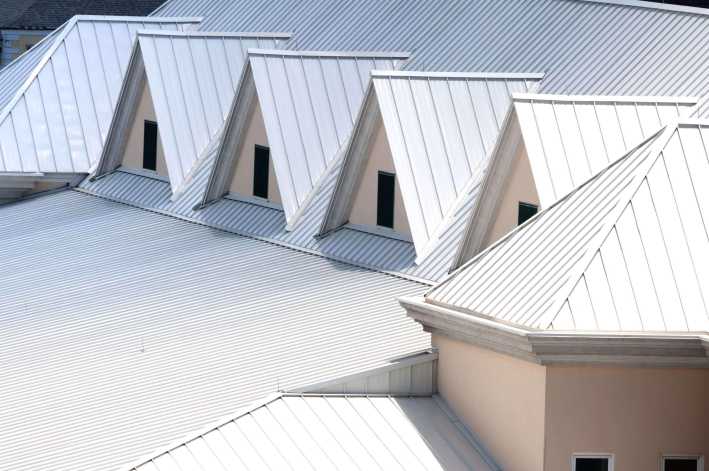
This widespread type of metal roofing is eco-friendly, lightweight, corrosion resistant, and has a high strength-to-weight ratio. It is constructed from thin, malleable panels that are best for architectural roofing. Please note that aluminum roofing does not serve for low-slope roofs. The minimum required slope should be 3:12.
Aluminum is the best bet for those who seek a relatively inexpensive roofing option that can serve for decades without much maintenance. The cost of aluminum shingles ranges from $315 to $600 per square. The final estimate dramatically depends on the roofing sheet style, roof pitch, and job location.
Take a look at the average aluminum roofing costs, including materials and labor.
| Roof type | Cost (per square foot) |
|---|---|
| Corrugated aluminum roofing | $9 to $13 |
| Standing seam aluminum roofing | $11 to $17 |
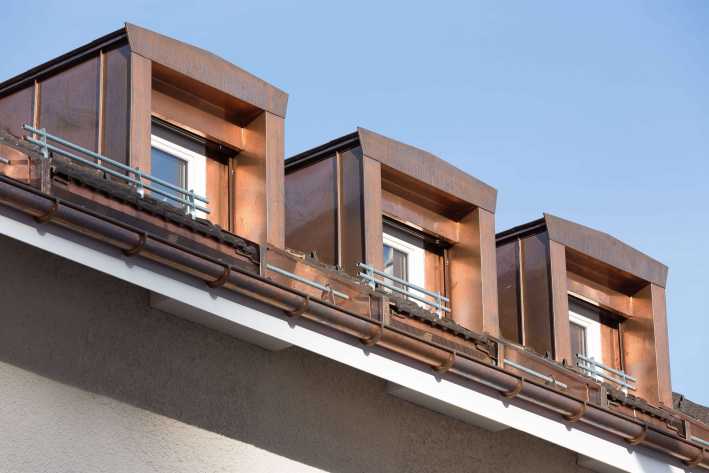
Copper is one of the older roofing types, with its first mention dating back to Ancient Egypt. It has a unique appearance as it changes color over time, turning into a blue-green or brown patina. The longevity of a copper roof is higher than that of its aluminum and steel counterparts. You can expect it to serve from 60 to 100 years and more. With this unmatched durability, some householders may earn lower insurance rates, enjoying a higher return on investment.
Copper roofs are the most expensive of their other metal counterparts. Zinc is the only metal roofing with approximately the same price per square. The average cost to install a copper roof on a typical 3.000 square foot home is $42.000, including material and labor. The high-end price might be $54.000, while the low-end one is $30.000. Factors that add to the metal roof cost include roof construction, its pitch, and the rates of local roofing professionals. The ultimate price quote also depends on the selected copper roofing type and thickness.
Take a look at the average copper roof cost, including materials and labor.
| Roof type | Cost (per square foot) |
|---|---|
| Standard copper roofing | $10 - $18 |
| Corrugated copper roofing | $19 - $28 |
| Standing seam copper roofing | $23 - $35 |

Steel is an alloy, the main component of which is iron. This durable material is widely applied in construction, accounting for over 50% of world steel demand. Steel is used to reinforce buildings' structures, clad exterior walls, and install commercials and residential roofs.
Steel roofing is lauded for its sturdiness and longevity (the average lifespan is 60 years). This material costs less than its aluminum, zinc, and copper counterparts. Plus, it does not require much investment in installation and maintenance.
Steel roofs come in three types - galvanized, galvalume, and weathering. They vary by appearance, durability, and cost. The most sought-after metal roofing, though, is corrugated steel roofing. It offers a fantastic combination of durability, lightweight, and long service life.
We have recently mentioned that steel roofing comes in several types that vary by properties and cost. Galvalume steel has an aluminum coating that ensures its durability and appealing look. It's probably the most affordable of all three types of steel roofing, costing about $140 per square. Galvanized steel is coated with zinc for better corrosion resistance. It's a common choice for commercial and residential properties as it ensures unmatched durability, weatherproofing, and corrosion resistance. The average cost of a metal roof runs about $380 per square. Stainless steel is on the high end of the scale. This premium material is used to cover high-end commercial and residential properties. The cost per square is $800. Plus, stainless steel requires higher installation spending, ranging from about $12.50 per square foot.
Take a look at the average steel roofing cost, including materials and labor.
| Roof type | Material cost (per sq.ft.) | Installation cost (per sq. ft.) |
|---|---|---|
| Galvalume roofing | $1.5 - $2.5 | $4 - $5.50 |
| Galvanized roofing | $3.35 - $4.25 | $8 - $10 |
| Stainless steel roofing | $10 - $16 | $12.50 - $15.50 |

You can see the term "tin roofing" in the context of steel or metal roofing, as they are often used interchangeably. Tin was introduced as a canning material and then adjusted by DIY enthusiasts who started using it as a roofing coverage.
These days, tin is rarely used compared to other metal roofing options. Sheets made of this material have been virtually phased out. However, there are still a lot of homeowners whose roofs are covered with tin. They stay loyal to this roofing due to its high corrosion resistance, unmatched durability, and classic look. Tin develops a gray patina over time that enhances its appearance and ensures a long service life.
The price of installing tin panels can vary based on the selected material, roof parameters, and labor cost in your area. The low-end cost is about $3.00 per square foot, while the high-end one is $14 per square foot. The price of installing a new tin roof on a typical 3.000 square home ranges from $10.000 to $32.500.
Take a look at the average tin roofing costs, including materials and labor.
| Roof type | Cost (per square foot) |
|---|---|
| Tin roofing with a zinc coating | $8.50 - $14.00 |
| Tin roofing with a lead coating | $7.00 - $12.00 |

Corrugated roofing is manufactured from aluminum or galvanized steel. It comes in metal sheets that are shaped into alternate ridges and grooves. There are a few styles and patterns of corrugated metal panels, but they all have better structural strength compared to their flat alternatives.
Corrugated roofing has a high strength-to-weight ratio and can serve more than 60 years. This material is relatively inexpensive and simple to install and upkeep. These advantages, plus unmatched resistance to weather extremes, make corrugated metal sheets roofing the best fit for commercial and residential buildings.
Most types of metal roofs can be made into corrugated sheets. However, galvalume and galvanized steel roofs are the most sought-after ones. They cost from $200 to $650 per square for materials plus labor. The price depends on the roof structure and size, the color and coating of corrugated sheets, and the rates of the selected roofing company.
Take a look at the average corrugated metal roof costs, including materials and labor.
| Roof type | Cost (per square foot) |
|---|---|
| Corrugated galvanized steel panels | $3.50 - $6.50 |
| Corrugated galvalume metal panels | $2 - $3.50 |
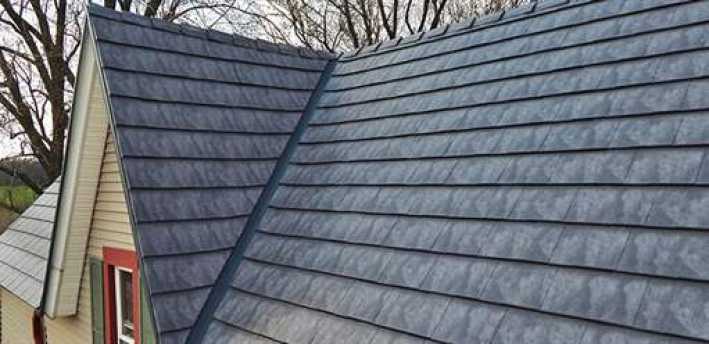
Architectural-grade metal panels are relatively new on the metal roofing market. They have become a top solution in exterior home design for the last few years as they match an appealing look and durability. Metal slate roofs mimic natural slate shingles but offer better flexibility and strength. Plus, they are more affordable and simpler to upkeep.
The material that forms the basis of the metal slate is steel covered with a reflective coating. This roofing option can serve up to 50 years and withstand the harshest weather conditions.
The average cost you should expect to pay for metal shingles that mimic slate ranges from $400 to $650 per square, material only. Some manufacturers include the trimming service at this cost. Please note that metal slate roofing is not a subject for DIY installation. You have to hire a pro to get the job done. The metal roof cost per square, including professional installation, will range from $1050 to $1650, depending on the size and complexity of the roof and the local labor rates.

Standing seam roofing is rather a type of panel than a material. Standing seam panels are made of different materials, but the most popular ones are steel, aluminum, copper, and zinc. They're characterized by a concealed fastener system and a vertically ribbed appearance. Panels vary by installation principle - some are snap-locked together, while others require special caps to be secured.
Standing seam metal roofs are weather-tight and rot-resistant. Their average service life is 50 years under proper installation, regular recoating, and adequate attic ventilation. The concealed design ensures better roof longevity as it does not let moisture and weathering affect fasteners. Another distinctive feature of standing seam panels is that their locking mechanism allows them to expand and contract as temperatures change.
As we said, standing seam roofing can be made from different materials, including aluminum, steel, zinc, copper, and others. The cost of a metal roof may vary depending on the selected material. The national average price ranges from $400 to $700 per square. Add labor to the material cost, and you will get about $1300 per square on average.
Take a look at the average standing seam metal roof prices, including materials and labor.
| Roof type | Cost (per square foot) |
|---|---|
| Aluminum standing seam roofing | $6.95 - $9.60 |
| Steel standing seam roofing | $3.50 - $7.75 |
| Zinc standing seam roofing | $7 - $17.50 |
| Copper standing seam roofing | $8 - $14.50 |
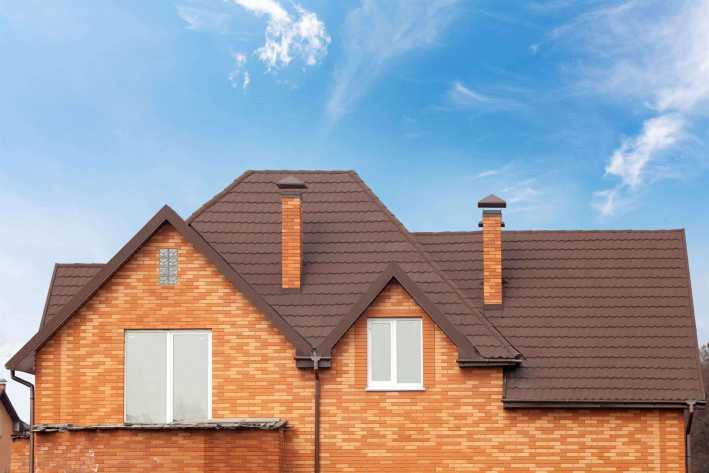
Stone-coated metal is a perfect blend of uncompromised durability and aesthetic appeal. This roofing material is made from steel panels covered with stone granules that allow for a wide variety of colors and textures. The distinctive feature of stone-coated metal roofing is that it imitates traditional roofing materials like shingles and shakes while preserving the original strength of steel.
Stone-coated metal roofing falls within costly materials that pay out in spades. Thus, you should expect to pay from $600 to $1100 per square for material only. The cost may differ from the style of panels. Homeowners spend an average of $780 per square for stone-coated roofing that mimics shakes or shingles. Barrel tile profiles cost around $810 per square. Installation costs around $12 per square foot and hinges on the roof shape and pitch, as well as local contractors' rates. Please note that sheathing and underlayment building can add to the final stone-coated steel roofing cost. To get an accurate estimate, refer to a local roofing company or send us your request by this link.
In plain words, roof underlayment is the protective roofing layer installed directly over the roof decking to keep it shielded from the elements and other external factors. Every roofing material requires a special underlayment that can withstand its weight and thermal expansion. It's highly recommended to select underlayment, not from the point of cost but its reliability and properties.
When it comes to metal roofs, underlayments are limited to three main options - high-temp, synthetic, and felt. Let us take a closer look at each type to weigh its merits and downsides.
High temp underlayment is a go-to option for metal roofs that produce more heat than other roofing systems, going back and forth during thermal expansion. This protective roofing material is composed of a top-grade, reinforced polyester fabric that ensures superior weatherproofing. High-temp underlayment suits low-slope roofs, protecting them from leakage and ice dams. This premium material costs around 20 cents per square foot.
Synthetic sheet underlayment is a relatively new roof protection technology that's become widespread in recent years. This material is made up by spinning together polypropylene with a polymer to create a protective layer between the roofing and decking. Synthetic sheet underlayment consists of thermoplastic polymers that make it durable and tearing-resistant. Besides, this material is lightweight and does not require special skills to be installed on the deck. It's also great to withstand high temperatures. The cost per square foot of synthetic underlayment ranges from 15 to 90 cents, depending on the manufacturer and material quality.
Felt underlayment, also called tar paper, is one of the most affordable and widespread protective roofing materials used for steep-sloped metal roofs. As its name implies, asphalt-soaked felt is made of a natural or synthetic base (cellulose or fiberglass) and covered with asphalt for better water resistance. Unfortunately, this protective material has drawbacks like poor heat resistance and reduced service life. The average cost of a 15-pound felt ranges from 5 to 7.50 cents per square foot, while its 30-pound analog costs around 12.50 cents per square foot.
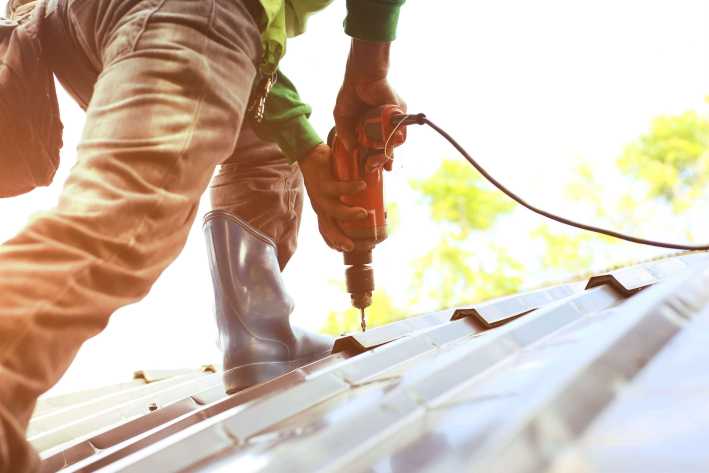
Metal is a robust, long-lasting material that can serve for decades without much upkeep. Nevertheless, as well as any other roofs, metal ones should undergo annual inspections to prevent potential problems and premature deterioration.
Regular surface and structural upkeep are essential to keeping a metal roof in tip-top condition. Some of these maintenance tasks can be performed without professional assistance. However, it's critical to consider the slippery metal roof surface and take corresponding safety measures.
The scope of surface-level metal roofing maintenance tasks to perform annually:
The scope of structural metal roofing maintenance tasks to perform annually:
Metal roofs are one of the most complicated to install. Depending on the selected roofing type, panels can be heavyweight and require on-site cutting. Besides, they can be slippery when wet or freshly coated. Those metal roofing options that feature a concealed fasteners system are even more tricky to work with as a roofer should possess a specific experience to mount them on a top.
So, in addition to the safety risks that accompany working on a metal roof, an unprofessional installation can drastically reduce a roof's service life and bring unexpected spending on repair and replacement. Unless you have a special certification in working with a particular type of metal roofing, you probably don't have the needed equipment or knowledge to do the job right.
If you want to get the most out of your metal roofing, entrust its installation to proven contractors who have undergone special training and know all ins and outs of working with metal panels. MyHomeQuote is always here to connect you with trusted roofing crews operating in your area. We commit to providing you with price quotes from roofers with enough expertise and positive client feedback.
Leave your request on our platform for a quick metal roofing installation estimate. It does not take you a dime to learn the local roofing prices with MyHomeQuote.
GET THE ESSENCE OF RELEVANT HOME
IMPROVEMENT TOPICS IN LESS THAN 5 MINUTES

Are you looking for a suitable covering material for your next roofing project? Consider concrete...

Are you in the market for a roofing material that combines uncompromised durability and aesthetic...

Stay tuned!